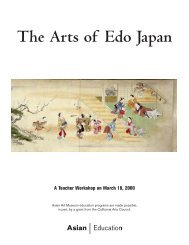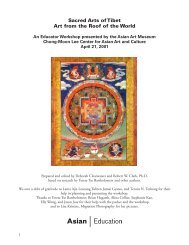Teacher Packet: Chinese Brushpainting (.pdf) - Asian Art Museum ...
Teacher Packet: Chinese Brushpainting (.pdf) - Asian Art Museum ...
Teacher Packet: Chinese Brushpainting (.pdf) - Asian Art Museum ...
Create successful ePaper yourself
Turn your PDF publications into a flip-book with our unique Google optimized e-Paper software.
Slide 20<br />
Brushstrokes: Styles and Techniques of <strong>Chinese</strong> Painting<br />
Herons and Reeds<br />
Yamamoto Baiitsu (1783-1856)<br />
Edo period<br />
Hanging scroll, ink and colors on silk<br />
B65 D14<br />
Bird and flower compositions of all styles were particularly popular<br />
in Japan where intimate, lyrical views of nature were favored<br />
in painting, decorative arts, and poetic imagery. In this picture by<br />
Yamamoto Baiitsu, the viewer enjoys a close-up view of the complexity<br />
and richness of life at the water's edge. One can imagine<br />
that it won't be long before the heron snags the small fish or frog<br />
it is intensely hunting. Baiitsu was an accomplished artist of the<br />
nanga school, but also a very sensitive observer of nature. In his<br />
paintings he is interested in capturing artistically how plants grow,<br />
bend, and even wither. He notices and records the forms, movement,<br />
and spirit of the birds. His experience of <strong>Chinese</strong> models for<br />
painting came from actual paintings recently imported to Japan,<br />
rather than from the copy books and theoretical writings which<br />
were so influential with other nanga painters. Working from examples<br />
of both professional and amateur styles, he acquired a dazzling<br />
mastery of <strong>Chinese</strong> brushwork techniques.<br />
These reeds, lotuses, and herons combine in a xieyi style with artfully<br />
applied ink and color washes. Although the overall effect is<br />
loose and free, much of the painting has been created with a carefully<br />
controlled use of washes in a modified boneless style similar<br />
to Yun Bing's (slide 15). Outlines are not drawn, but their appearance<br />
is effectively evoked by the pooling of two layers of wash at<br />
the edge of the forms. Tarashikomi, a particularly Japanese technique<br />
that gives a mottled color effect, has been used on the floating<br />
water plants and reeds. In this wet-on-wet technique, small or generous amounts of color or darker<br />
ink are dropped onto a layer of wash that is still wet. The color spreads a bit and only partially blends<br />
with the undercoat. Fluid orchid-leaf lines describe the contours of the necks of the herons; nail-head<br />
rat-tail lines outline the wing feathers, and dry brush strokes indicate the soft feathers of his body. The<br />
delicate flower heads of the reeds were also painted with a dry- or split-brush technique.<br />
Baiitsu's use of color is subdued. His range of colors is soft and he then mixes them with ink or applies<br />
them over pale ink wash to further reduce their intensity. Complex brushwork, controlled washes,<br />
muted colors, and densely overlapping forms create a convincingly realistic and decorative image.<br />
Yamamoto Baiitsu was born in Nagoya and returned there to paint for the Tokugawa rulers after<br />
a period of travel and study in Kyoto and Edo. Through his early training he learned modes of<br />
decorative composition in the Kano school and to paint from observation of nature in the Maruyamo-<br />
25 <strong>Asian</strong> <strong>Art</strong> <strong>Museum</strong>
















